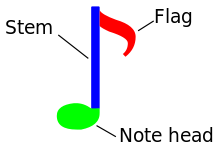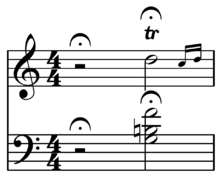Getting Your Rhythm Right (Part 2)
First of all let’s understand what the funny squiggles on a score mean.
It’s a bit more technical here, but hang in there, we’ll take it one step at a time, yeah?
===
Basic symbols:

On a score, the notes (the circle things) represent when you’re supposed to sing. The rests represent when you’re supposed to rest (ie: not sing/possibly breathe).
Although it’s unintuitive, the “quarter” note is actually the standard value of 1 beat. It’s also called a crotchet (not very important).
The 4/4 thing at the side is called a time signature. The top number tells us how many standard notes there are in a bar, and the bottom tells us what the standard note is.

For us in acapella music, the 3 most common time signatures are as such:

- 4/4 (aka common time, cos it’s so common)
- It’s also represented by C
- 2/2 (aka cut common time)
- It’s also represented by C with a vertical line through it
- It’s very similar to 4/4, but has the whole half time/break it down feel (refer to example 1 below)
- Notes being emphasised half as often, with twice as long in between
- 6/8
- It means 6x of the eighth notes (called quavers)
- The key difference between this and 3/4 timing is what notes are emphasised (refer to example 2 below)
- 6/8 is far more common
To illustrate 6/8 vs 3/4 a little better, here’s a little table to help:


===
Let’s zoom in on the singing bit first: the notes



There’s a few examples we can illustrate from this diagram.
- With the 4/4 time signature, we know the total number of notes in the bar = 4x quarter notes = 2x half notes = 8x eighth notes, etc.
- Aside from the whole note (4 beats), the other notes all have a straight line sticking out of them. This is the ‘stem‘, and it usually points either upward or downward, in the direction of the centre of the bar.
- For notes on the middle line, they can point in either way.
- For 8th/16th notes, they have an extra ‘flag‘ or two stuck to the stem.
- When written adjacent to each other, the 8th/16th notes have their flags joined together in various combinations.
- Key concept: the notes are grouped together to represent 1 beat, except for 4x 8th notes which represent 2 beats.
- When grouped together, the stems all point in the same direction.
===
Now we can talk about the rests:


- For the 4 beat rests and and 2 beat rests, they look very similar, but the difference is whether they stick out from the top or bottom of the line.
- Rests are always drawn in the same place; centralised around the middle of the bar.
- The 8th and 16th rests are not joined together, unlike in notes
- Notice how the rests interfere with the joining of the flags in the 8th/16th notes. The red boxes each represent 1 beat worth of notes/rests
===

This is a special symbol I’d like to highlight: the fermata. It looks like an arch with a dot under it.
Whenever you see this, it basically means pause for dramatic effect. So the singers would hold the note/rest for as long as their conductor wants them to.
This shows up especially often at the end of songs, or between songs in a medley.
===
Last bit for this article: dotted symbols, ties and slurs.

- The dot is like a +50% to the original note value (or a x1.5 multiplier)
- Note the curvy line on the right side of figure 10: this is a tie, and it means that you sing the two notes continuously without a break
- The purpose of tying notes is to make it easier to read
- Eg: Tying together a note that starts in one bar but ends in the next bar, as shown above

- Ties are when the two notes joined together are the same pitch. They do not need to be the same length (refer to figure 10)
- Slurs are when two notes joined together are different pitches. They are supposed to be sung without a break in the middle; slide from the 1st note into the 2nd.

- You can dot a dot (double dotting)
- The 2nd dot = 50% of the value of the 1st dot
- ie: double dot = x1.75 multiplier
===
Phew. Congratulations on making it this far!
Unfortunately, there’s no better way to familiarise yourself with things than to read more music 😦 but keep at it, you’ll slowly but surely get better!
In the next article, we’ll learn a way to write our pulse on any acapella score 🙂
Hope it helps!
~ Andrew